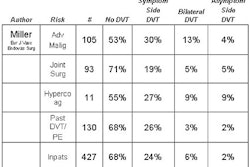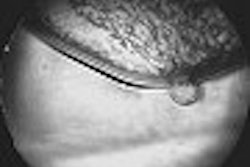
(Ultrasound Review) Demographic, anatomic, and urodynamic factors may affect the bladder wall thickness at the trigone, dome, or both, according to researchers at Mackay Memorial Hospital in Taipei.
Dr Jenn-Ming and colleagues determined that a thickened bladder wall was a common finding in women with lower urinary tract symptoms, but was not found in those with a hypersensitive bladder.
"The aim of this study was to explore the association between a thickened bladder wall at either the trigone or dome on ultrasonography and demographic, anatomic, and urodynamic variables," the authors wrote in the Journal of Ultrasound in Medicine.
In order to examine the factors that affected bladder wall thickness, they studied 492 women with lower urinary tract symptoms, who also had urodynamic studies. The group included "248 patients with urodynamic stress incontinence, 38 with detrusor overactivity, 39 with mixed incontinence, 35 with hypersensitive bladder, 42 with voiding difficulty, and 90 with normal urodynamic findings."
Patients with urinary tract infections were excluded from the study. A previous study by Khullar et al determined that a bladder wall thickness greater than 5 mm showed a sensitivity of 84% and specificity of 89% for diagnosing detrusor overactivity.
Patients were scanned using a 5 MHz transvaginal transducer. They were placed in the supine position and asked to have a comfortably full bladder. The bladder neck position, bladder neck funneling, proximal urethral opening, and any cystocele, prolapse, or herniation of the bladder base inferior to the urethrovesical junction was noted.
Measurements of the bladder neck position were obtained before and during Valsalva maneuver. "Two lines were drawn on the frozen images, one from the lower border of the pubic symphysis to the bladder neck (internal urethral orifice) and the other denoting the midline of the pubic symphysis. The position of the bladder neck was quantified by measuring the angle between these two lines," they reported.
They defined the rotational angle as the difference between these two angles before and during Valsalva maneuver. The bladder wall thickness was measured after bladder emptying at the thickest aspect of the trigone and dome. A correlation between the bladder wall thickness at the trigone and dome was demonstrated.
"Age, resting bladder neck angle, urethral mobility, and maximum urethral closure pressure were associated with bladder wall thickness at both the trigone and dome," according to the authors.
"In conclusion, our findings indicate that the pathogenesis of a thickened bladder wall is multifactorial and that thickening at the trigone or dome may imply different urodynamic changes," they wrote.
Bladder wall thickness on ultrasonographic cystourethrography: affecting factors and their implicationsYang, J., et. al.
Division of urogynecology, department of obstetrics and gynecology, Mackay Memorial Hospital, Taipei.
J Ultrasound Med 2003 August; 22:777-782
By Ultrasound Review
October 9, 2003
Copyright © 2003 AuntMinnie.com



















